Brazil
-
- From Norway to Brazil (and Back) Maritime Logistics Professional, Q2 2013 #48
Norway’s involvement with this South American energy powerhouse predates the current oil boom. Today’s commerce model flows in both directions in ever increasing frequency and volumes.
Make no mistake about it: Brazil is important to Norway. So important that the Norwegian government’s strategy for developing additional business here includes broad reaching initiatives such as Innovation Norway (IN), providing advisory and networking services for Norwegian companies in Rio de Janeiro, INTSOK (Norwegian Oil and Gas Partners – offering a range of services to the oil and gas industry in close cooperation with Innovation Norway), The Norwegian Seafood Export Council (marketing Norwegian seafood industry in Brazil) and branches of the Norwegian–Brazilian chambers of commerce in Rio de Janeiro, São Paulo and Oslo. Additionally, The Norwegian Embassy, the Consulate General in Rio de Janeiro (co-located and cooperates closely with Innovation Norway, INTSOK and the Seafood Export Council) also play an important coordinating role.
Global energy heavyweights Brazil and Norway have been doing business for decades. Over time, Norwegian firms of all sizes have established and maintained a physical presence in Brazil. The ongoing oil boom in Brazil has only solidified these ties and Norway’s recognized leadership in oil & gas technology have been well received locally and put to good work in the southern Hemisphere. Trade between the two nations has increased sharply – almost 300 percent increase – in the last decade alone.
In the beginning, the most visible ties between these seemingly different and geographically separated countries included primarily the cod and newsprint trades. That’s anything but the case, now.
Weighing in on all of that last month was the Norwegian Consul for Commercial Affairs in Rio de Janeiro, Helle Moen and Henrique Schlaepfer, Area Director for Latin America, Wilhelmsen Ships Service. Moen told MarPro in April, “The size of the Brazilian market, the country’s diversified economy and the growth of its middle class offer opportunities for a broad range of Norwegian companies.” She added, “the Norwegian petroleum and maritime sector is already strongly represented here. And, Brazil is one of Norway’s most important export markets and one of the most important recipients of Norwegian investments.”
It turns out that doing business in Brazil has its rewards. Those rewards do not come without challenge – or risk.
Norway: Right at Home in Brazil
It isn’t so much a story of what Norway can bring to Brazil as much as it is a list of who is already here. And that list is a veritable “who’s-who” of over 150 Norwegian companies, 95% of whom are related to the oil & gas and shipping business. The major players with a significant local presence include, among others, Statoil, Kongsberg, Aker Solutions, Farstad, Solstad along with a raft of Norwegian financial institutions. That said, Helle Moen insists, “The majority of the companies established here are small and medium sized companies.”
Wilhelmsen Ship Service is one such Norwegian company, providing a wide range of products and services to the maritime industry. Wilhelmsen Ship Service do Brasil today operates from 40 service locations, catering to ships and rigs all along the Brazilian coastline. Henrique Schlaepfer told MarPro in April, “We have been in Brazil for a long time. There is no doubt that we have experienced tremendous growth here; in the last 3 years alone our sales in Brazil have doubled.”
Schlaepfer says that the potential for even greater growth is still very real. The advent of the energy era in Brazil has more than tripled in the number of Norwegian firms on Brazilian soil in the last decade alone. And, because Norway has always been a leader in exporting technology and expertise to the global oil patch, their presence in the world’s fastest growing offshore market is a natural, convenient and easy fit.
Away from the Coast, Close to the Heart
Leveraging its rich hydropower resources, Norway has long been Europe’s largest aluminum producer. This involved early cooperation with Brazilian companies to ensure the availability of raw materials. To that end, Norway-based Hydro and the Brazil bulk commodity heavyweight Vale concluded an agreement in 2011 that will benefit both players into the foreseeable future.
In the area of renewable energy, Norway is already in close dialogue with Brazil to promote hydropower and other forms of renewable energy. As Brazil ramps up its nascent hydropower development program, Norway’s expertise and financial help will likely be a big part of that, as well as some local bioethanol projects. And, consistent with all of that, Norway is also known for its attention to environmental legislation and standards, and is keen to help these industries develop in as clean and environmentally sensitive manner. Indeed, Environmental issues are high on the political agendas of both countries, and Brazil today finds itself at the forefront of efforts to reduce deforestation, holds a leading position in biofuel production and is a key player in global processes concerned with the environment and sustainable development. As their industrial relationship increases, both nations are cooperating to provide for sustainable development. Moen adds, “Norway wishes to be an active and constructive cooperation partner in these efforts. Norway supports Brazil’s efforts to reduce emissions from deforestation and forest degradation through its contribution to the Amazon Fund. Even before the establishment of the Fund, Norway had a long history of support for Brazilian indigenous people’s organizations both in and outside the Amazon region.”
Balancing Opportunity with Risk
According to Norway’s Helle Moen, “Brazil offers many opportunities for Norwegian companies, but they also need to take active steps in to deal with local challenges. For example, Companies tend to find the Brazilian legislation and taxation system complex.” Beyond this, intense competition for qualified local labor is fueled by local content requirements that companies must respect. Moen adds, “IN aims to make Norwegian companies competitive in international markets. We support the business development of Norwegian industry through financing, competence development training, temporary office facilities in Rio, market analysis, partner search and business development plans.” In short, IN’s main goal is to contribute to the increase the success rate of the Norwegian companies in foreign markets, Brazil in particular.
Henrique Schlaepfer, Area Director for Latin America, Wilhelmsen Ships Service is candid about what it takes to make it here. He explained, “Major challenges include the bureaucracy and protectionist policies.” For example, he said, and because of local taxes and regulations, foreign manufactured products can be up to four times as expensive as products manufactured in Brazil. Schlaepfer insists that he can compete, however. “Our answer is to focus on our network, our proven quality and our ability to deliver at the right time at the right price.”
On the subject of bureaucracy, he pointed to the large number of governmental agencies that add to an already difficult documentation process for foreign companies doing business here. That said, Henrique also reported that the Brazilian government was taking strides to improve its performance, digitalizing documentation, decreasing the amount of documents required and engendering a mentality of efficiency into government service. Wilhelmsen’s efforts to engage an efficient workforce have also presented problems – training and education in particular – even as they try to employ a more local staffing policy here. For this reason, WSS actually certifies even local staff from Wilhelmsen Headquarters in Norway, in order to maintain their standards.
As Brazil struggles with the long term debate over of how best to distribute the vast financial benefits of the oil and gas boom to society, Norway watches with interest, but largely from the sidelines. According to Moen, Norway’s fund was established to ensure that tomorrow’s generations benefit from today’s oil wealth. For example, the Norwegian Government Pension Fund Global (GPFG) was structured to safeguard economic stability for both the long and short term, with the intent of ensuring that revenues from the petroleum sector are gradually phased into the Norwegian economy from the GPFG to a level that can be sustained. But Moen also says, “Nevertheless, Norway does not intend to interfere in internal questions of Brazil.” That said, the Norwegian Fund held $5.9 billion worth of equities in 98 different companies, and $732 million of bonds from seven bond issuers in Brazil.
Commerce: a two-way street
Longstanding commercial ties that bind both nations move in both directions. Starting with the dried codfish and coffee trades in the 1800’s, Norway’s imported goods from Brazil have always been important. These came to USD $1.4 billion USD in 2012, an increase of 11% from 2011. And Brazilian companies – notably Vale’s 2011 investment in Norsk Hydro (via Norsk Hydro ASA’s acquisition of Vale’s aluminium activities) – are significant investors in Norwegian enterprises. Today, Vale’s 22 percent ownership in Norsk Hydro makes Vale the second largest shareholder in Norsk Hydro after the Norwegian state.Preparing for tomorrow - Together
Consistent with its far reaching plans for offshore oil development, Brazil is actively building a fleet of offshore service vessels (OSV) to service those needs. The considerable backlog of Brazilian shipyards – 367 vessels, of which about 70 are OSV’s – includes a clear effort to build at home to service local requirements. It also incorporates a vast amount of technology, knowhow and equipment from other places. No one country is more involved in that effort than is Norway.
As a leading manufacturer and operator of OSVs, Norway has always been closely linked with this fast growing market; here, in the U.S. Gulf of Mexico and other markets, too. That’s because as Norway’s oil & gas industry grew up in the rough weather of the North Sea, so too did the need for tough, well-crafted and comfortable vessels. Many innovations, therefore, emanating from Norway - architectural design, dynamic positioning, eco-friendly, dual fuel propulsion systems, cranes and world-renowned crew accommodations are coming to the offshore Brazil markets.
As many as nine local shipyards, accounting for more than USD $4 billion in investments, affirms UNCTAD’s 2012 data that Brazil’s shipbuilding program is one world’s largest, especially as compared to the size of its own fleet. Much of that is being accomplished through joint ventures with others. And, the latest Petrobras business plan (2013-2017) – Brazil’s major local oil and gas firm – predicts and plans for substantial growth in that sector. That leaves plenty of room for more growth in trade between Norway and Brazil.
Uncommon Bonds – Critical Ties
Arguably, and in the global arena, there may be no two more dissimilar nations with more in the way of economic ties today than Brazil and Norway. Nevertheless, from the North Sea all the way to the Southern Atlantic Ocean, commerce flows in both directions, in the form of trade, technology and a common desire to improve both bottom lines. From the Brazilian side of the equation, the growing pains that impact business are slowing being sorted out. Separately, Norway’s government continues to invest heavily in terms of time and money to make sure that the relationship(s) continue to flourish. Very much a work in progress, it is an imperfect relationship, one with deep historical roots, and staying power that is likely to grow even stronger.(As published in the 2Q edition of Maritime Professional - www.maritimeprofessional.com)
-
- Interview: Woodson Ferreira, Aker Solutions, Brazil Marine Technology, Sep 2017 #18
It is part of the company's strategy (for Brazil) to become a competitive international hub for projects with operators such as Statoil, Total, BP, among others. It is still a time of uncertainty and caution, but we are optimistic about the gradual recovery. The Brazilian potential remains one of the
-
- Offshore Brazil: The Libra Field & Brazil’s Pre-Salt Policy Maritime Reporter, Nov 2013 #56
Brazil’s Libra pre-salt field, in Block SS-AUP1 in the Santos Basin, with estimated recoverable oil volumes of 8-12 billion barrels of oil equivalent (BOE) and in place volumes of between 25-40 billion BOE, was the country’s first pre-salt field to be auctioned. The rules governing this historical
-
- Interview: Davide Breviglieri, CEO of Azimut Yachts do Brasil Maritime Reporter, Sep 2019 #22
the world’s largest motor yacht builder (global orderbook 2019). For nearly 10 years Azimut has been producing a wide range of luxury motor yachts in Brazil. Maritime Reporter´s correspondent in Brazil interviewed Italian executive Davide Breviglieri, CEO of Azimut Yachts do Brasil.Founded in 1969
-
- AET Grows in Brazil Maritime Reporter, Nov 2018 #60
With the ongoing development of deepwater pre-salt plays and a decreased demand on local content in tankers and other vessels, Brazilian national operator Petrobras and other super-majors have been looking abroad for better rates and reliable operators of shuttle tankers. Claudio Paschoa, Maritime Reporter&rs
-
- Voices: Paulo Cesar P. Freitas, Norsul Maritime Reporter, Nov 2017 #72
To better understand the challenges faced by ship operators in Brazil, Maritime Reporter’s correspondent in Brazil spoke to Paulo Cesar P. Freitas, Fleet Manager for Norsul Shipping company, one of the major shipping operators in Brazil. Norsul by the Numbers Established in 1963 and operating continuous
-
- Brazil Class Maritime Reporter, Jul 2013 #30
To understand how ABS and DNV participate in Brazil’s complex and challenging Maritime and O&G industries, MR spoke to ABS’s João Carlos Ferreira , DNV’s Tommy Bjørnsen and their colleagues in Rio de Janeiro. ABS Group The American Bureau of Shipping (ABS) is a non-profit classification society founded
-
- DOF Brasil Marine Technology, Jun 2013 #28
During a recent tour through the region, Claudio Paschoa, MTR’s Contributing Editor in Brazil, was able to post some questions to Eirik Tørrenssen, Country Manager Brazil, DOF Brasil. With offices in the O&G hubs Macaé and Rio, Tørrenssen is hard to corner, but between trips and meetings he managed to
-
- The Digital Oilfield Microwave Communication Offshore Brazil Maritime Reporter, Nov 2015 #42
With most offshore wells in Brazil located between 30 and 300 km from the coast, communication with offshore assets has not always been straightforward or reliable. Some operators and service providers still use traditional maritime VSAT services for coverage offshore Brazil, yet the introduction of Microwave
-
- DeepOcean Deep Water Operations in Brazil Marine Technology, Jan 2015 #24
services including Survey and Seabed-mapping, Subsea Construction and Installation, Seabed Intervention, IMR, and Decommissioning. Since its entry into the Brazilian offshore market, DeepOcean has accumulated extensive experience in deepwater operation, having become a preferred partner to national operator Petrobras
-
- Advanced Subsea Marine Technology, Jan 2013 #32
At the Cutting Edge of Deepwater Studies for the O&G industry in Brazil For more than 35 years, Advanced Subsea (AS) has been deeply involved in marine technological innovation. Through steady research and partnerships with research institutes in France and Brazil, Advanced Subsea has been developing
-
- Seatorque Boost for Brazil’s Biggest Superyacht Maritime Reporter, Nov 2013 #76
Brazilian superyacht builder MCP Yachts credited Seatorque Control Systems for contributing to the outstanding performance of its latest launch – the Hemisphere 140 Raffaella II. Incorporating Seatorque’s enclosed drive shaft system, the 43m aluminum vessel, powered by twin Caterpillar C32 1825 HP engines
-
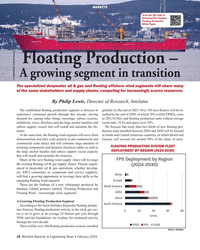 )
February 2024 - Maritime Reporter and Engineering News page: 18
)
February 2024 - Maritime Reporter and Engineering News page: 18between 2024 and 2030 will be located At the same time, the ? oating wind segment will move from in South and Central American countries, of which Brazil and demonstration and pilot scale projects to pre-commercial and Guyana will account for around 90% of the share of units. commercial scale arrays
-
 )
November 2023 - Maritime Reporter and Engineering News page: 8
)
November 2023 - Maritime Reporter and Engineering News page: 8Services 1,254.7 69 Bram OTM 705.9 33 Tidewater Offshore Operations 689.7 49 (By Country) United States of America 8,386.2 894 Norway 3,319.1 216 Brazil 3,257.6 248 Singapore 2,754.9 483 China 2,571.0 450 Top OSV Buying Companies (Spend) Buyer Company Spend ($) # Vessels Tidewater Marine 596.7
-
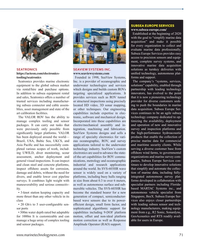 )
September 2023 - Marine Technology Reporter page: 71
)
September 2023 - Marine Technology Reporter page: 71a the high-performance hydroacoustic has been deployed around the world— range of specialty electronics for vari- products that enable the collection of Brazil, USA, Baltic Sea, UKCS, and ous oceanographic, ROV, and survey precise marine data for commercial Asia Paci? c and has successfully com- applications
-
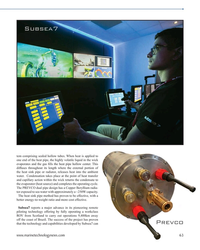 )
September 2023 - Marine Technology Reporter page: 63
)
September 2023 - Marine Technology Reporter page: 63pioneering remote piloting technology offering by fully operating a workclass ROV from Scotland to carry out operations 9,400km away off the coast of Brazil. The success of the project has proven Prevco that the technology and capabilities developed by Subsea7 can www.marinetechnologynews.com 63 MTR
-
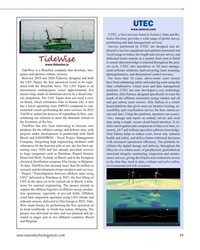 )
September 2023 - Marine Technology Reporter page: 49
)
September 2023 - Marine Technology Reporter page: 49TideWise to ensure that knowledge is retained throughout the proj- www.tidewise.io ect cycle. UTEC also specializes in 3D asset manage- TideWise is a Brazilian company that develops, inte- ment software solutions, land surveying, laser scanning, grates and operates robotic systems. photogrammetry, and
-
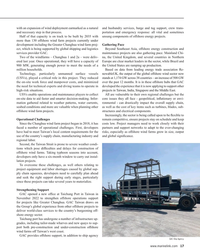 )
June 2023 - Maritime Reporter and Engineering News page: 17
)
June 2023 - Maritime Reporter and Engineering News page: 17, and several countries in Northern ered last year. Once operational, they will have a capacity of Europe are clear market leaders in the sector, while Brazil and 900 MW, generating enough power to meet the needs of a the United States are ramping up production. million households. Based on data from leading
-
 )
May 2023 - Marine Technology Reporter page: 42
)
May 2023 - Marine Technology Reporter page: 42projects include a particular Marine Telecom and Planova Planejamento e Construções, attention to installation operations and health and safety. It both Brazilian companies, which is responsible for the integra- is not uncommon for an entire project to be put on hold due tion of the Malha Óptica system.
-
 )
May 2023 - Marine Technology Reporter page: 40
)
May 2023 - Marine Technology Reporter page: 40last year awarded a contract by Zemax-Planova Consortium to provide expertise related to the Petrobras Malha Óptica ? ber optic system project, offshore Brazil. The project will link 13 FPSOs and one platform with two cable landing stations in Praia Grande, São Paulo, and Rio de Janeiro. MTR interviewed
-
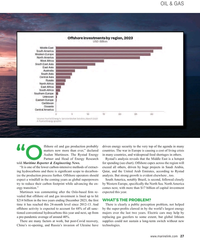 )
May 2023 - Maritime Reporter and Engineering News page: 27
)
May 2023 - Maritime Reporter and Engineering News page: 27should analysis. But strong growth is evident elsewhere , too. expect a windfall in the coming years as global superpowers South America, notably Brazil, is second, followed closely try to reduce their carbon footprint while advancing the en- by Western Europe, speci? cally the North Sea. North America
-
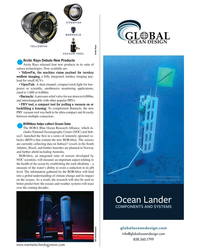 )
January 2023 - Marine Technology Reporter page: 43
)
January 2023 - Marine Technology Reporter page: 43of remotely operated ve- hicles (ROVs) that contain the new BORAbox. The sensors are currently collecting data on Subsea7 vessels in the South Atlantic, Brazil, and further launches are planned in Norway and further a? eld including Australia. BORAbox, an integrated suite of sensors developed by NOC scientists
-
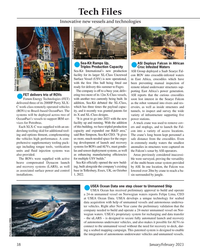 )
January 2023 - Marine Technology Reporter page: 38
)
January 2023 - Marine Technology Reporter page: 38into rivers and res- which has three times the payload capac- C work-class remotely operated vehicles ervoirs, as well as inside structures and (ROVs) to Brazil-based OceanPact. The ity, and it recently was granted patents for tunnels, to inspect and survey the wide systems will be deployed across two of
-
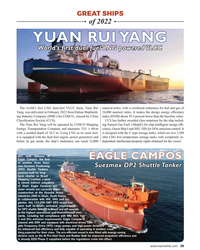 )
December 2022 - Maritime Reporter and Engineering News page: 39
)
December 2022 - Maritime Reporter and Engineering News page: 39, the ? rst of another three Suez- max Dynamic Positioning Suezmax DP2 Shuttle Tanker (DP2) Shuttle Tankers purpose built for long- term charter to Brazil Shipping I Limited, a whol- ly owned indirect subsidiary of Shell. Eagle Campos’ two sister vessels are currently under construction at the Hyundai
-
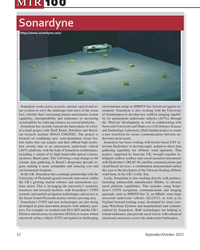 )
September 2022 - Marine Technology Reporter page: 52
)
September 2022 - Marine Technology Reporter page: 52recently entered the latest phase of a ? rst- Newcastle University and Thales on a UK Defence Science of-a-kind project with Shell Brasil, Petrobras and Brazil- and Technology Laboratory (Dstl) funded project to create ian research institute SENAI CIMATEC. The project is a new waveform for secure communications
-
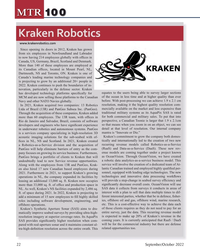 )
September 2022 - Marine Technology Reporter page: 22
)
September 2022 - Marine Technology Reporter page: 22in 2012, Kraken has grown from six employees in Newfoundland and Labrador to now having 214 employees globally with of? ces in Canada, US, Germany, Brazil, Scotland and Denmark. More than 140 of these employees are employed at its Canadian of? ces, located in Mount Pearl, NL, Dartmouth, NS and Toronto
-
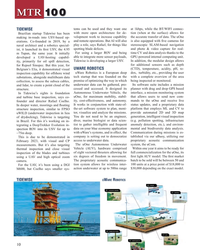 )
September 2022 - Marine Technology Reporter page: 10
)
September 2022 - Marine Technology Reporter page: 10MTR 100 tems can be used and they want one at 1kbps, while the BT/WIFI connec- TIDEWISE Brazilian startup Tidewise has been with more open architecture for de- tion (when at the surface) allows for velopment work to increase capability the accurate transfer of data. The uOne making in-roads into
-
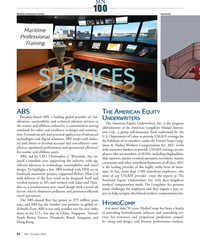 )
October 2022 - Marine News page: 54
)
October 2022 - Marine News page: 54new order share in the U.S., but also in China, Singapore, Taiwan, in providing hydrodynamic software and consulting ser- South Korea, Greece, Denmark, Brazil, Singapore and vices for resistance and propulsion prediction, propel- ler sizing and design, and forensic performance analysis. Hong Kong. 54
-
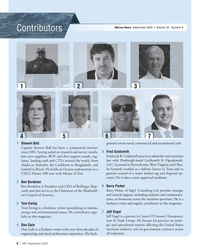 )
September 2022 - Marine News page: 6
)
September 2022 - Marine News page: 6Goldsmith & Ogrodowski, Alaska to Australia, the Caribbean to Bangladesh, and LLC. Licensed in Pennsylvania, West Virginia and Ohio, Iceland to Brazil. He holds an Oceans endorsement as a he formerly worked as a defense lawyer in Texas and as USCG Master 500 tons with Master of Tow. general counsel
-
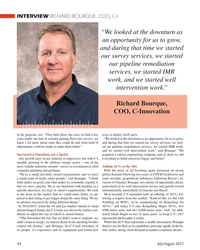 )
July 2022 - Marine Technology Reporter page: 44
)
July 2022 - Marine Technology Reporter page: 44well intervention service and growth overall speci? c direction; we react to client’s requirements. We look internationally, particularly in Guyana and Brazil. to the areas in the market that we could make better, as op- Most recently C-I expanded with an offering of AUVs fol- posed to just trying to get
-
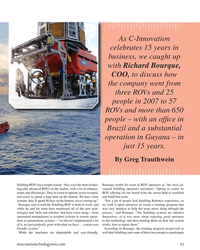 )
July 2022 - Marine Technology Reporter page: 43
)
July 2022 - Marine Technology Reporter page: 43Richard Bourque, COO, to discuss how the company went from three ROVs and 25 people in 2007 to 57 ROVs and more than 650 people – with an of? ce in Brazil and a substantial operation in Guyana – in just 15 years. By Greg Trauthwein Schilling ROVs for a simple reason: “they were the most techno- Bourque
-
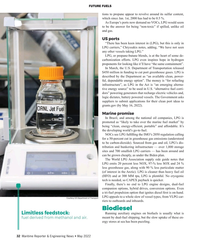 )
May 2022 - Maritime Reporter and Engineering News page: 32
)
May 2022 - Maritime Reporter and Engineering News page: 32powered vessels. The Government asks suppliers to submit applications for their clean port ideas to grants.gov (by May 16, 2022). Marine promise In Brazil, and among the national oil companies, LPG is promoted as “likely to take over the marine fuel market” by being “clean, energy-ef? cient, portable”
-
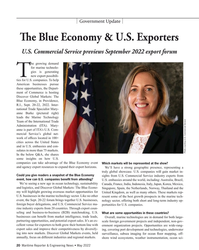 )
May 2022 - Maritime Reporter and Engineering News page: 20
)
May 2022 - Maritime Reporter and Engineering News page: 20.S. Commercial Service industry experts from event, how can U.S. companies bene? t from attending? U.S. embassies around the world, including: Australia, Brazil, We’re seeing a new age in ocean technology, sustainability Canada, France, India, Indonesia, Italy, Japan, Korea, Mexico, and logistics, and Discover
-
 )
May 2022 - Marine Technology Reporter page: 56
)
May 2022 - Marine Technology Reporter page: 56planning regional operations within the Image courtesy Nauticus Robotics Photo courtesy Impact Subsea Gulf of Mexico, Norway, the United Kingdom, and Brazil. The surface aspect of the ? eet is Hydronaut, an 18-m option- ally crewed autonomous surface vessel (ASV) that supports the controlled through
-
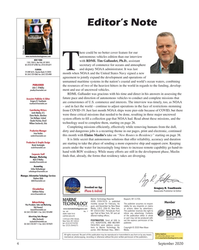 )
September 2020 - Marine Technology Reporter page: 4
)
September 2020 - Marine Technology Reporter page: 4Elaine Maslin, Aberdeen Tom Mulligan, Ireland system efforts to ? ll a collection gap that NOAA had. Read about these missions, and the Claudio Paschoa, Brazil technology used to complete them, starting on page 26. William Stoichevski, Oslo Completing missions ef? ciently, effectively while removing humans
-
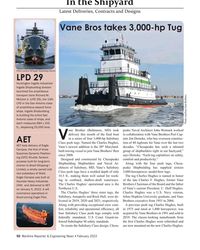 )
February 2022 - Maritime Reporter and Engineering News page: 50
)
February 2022 - Maritime Reporter and Engineering News page: 50comfort and productivity.” purpose built for long-term Shipbuilding Shipbuilders and Naval Ar- Along with the four push tugs, Chesa- charter to Brazil Shipping I chitects of Salisbury, MD, Vane’s Salisbury peake Shipbuilding has supplied sixteen Limited, a wholly owned indi- Class push tugs have
